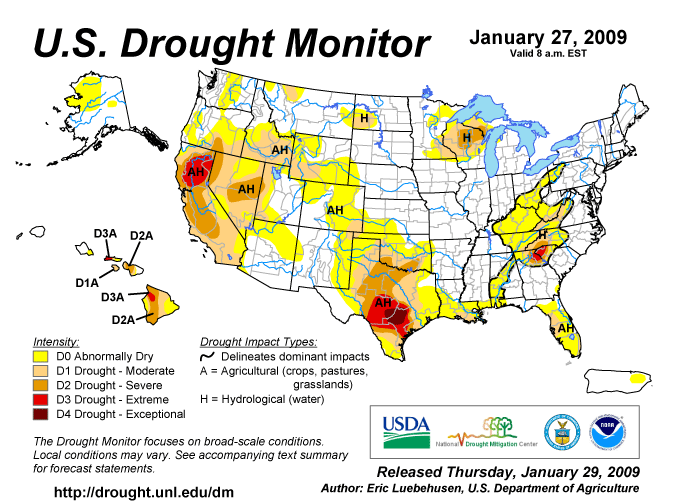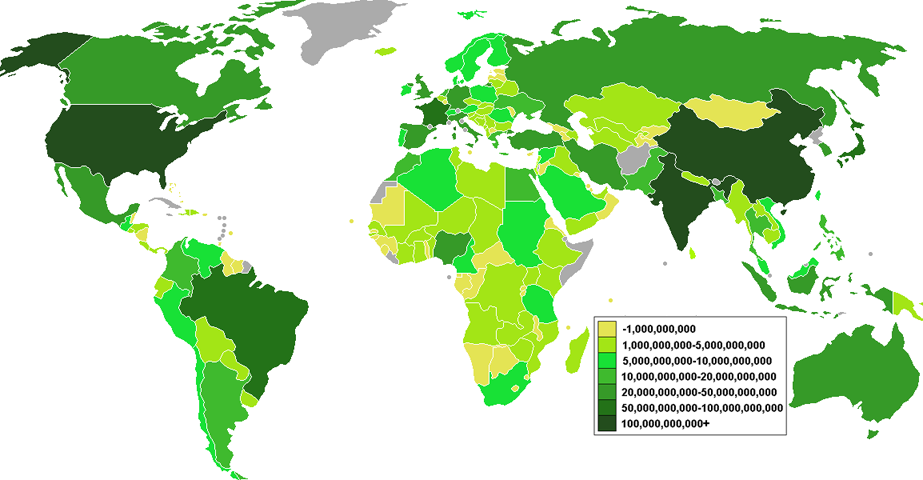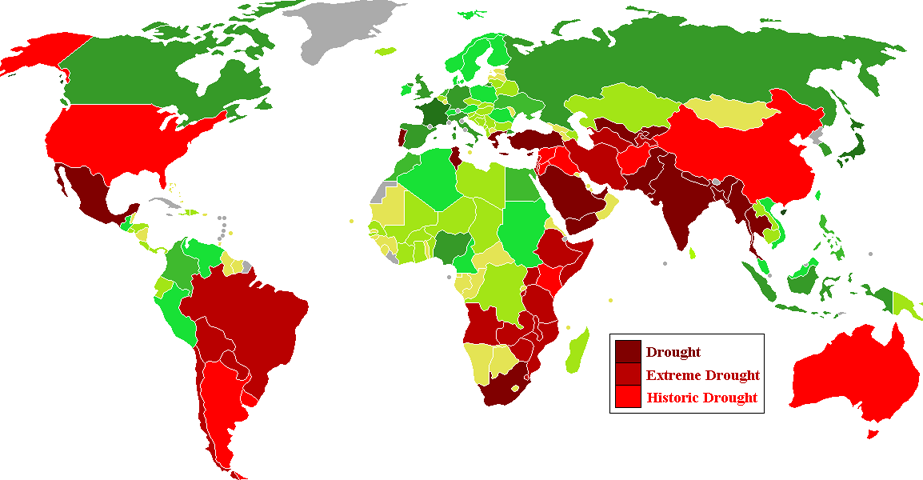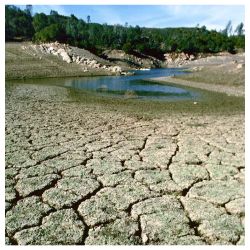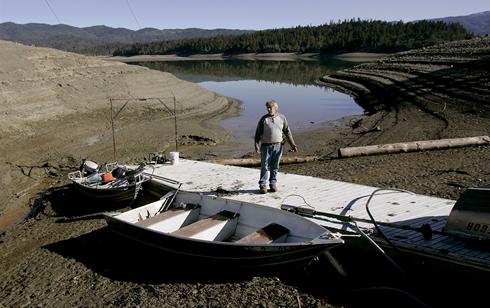|
1-27-09 - DREAM - I was living in California in our current house. Our
bathroom floor was covered with a thick layer of folded out newspapers to
protect the flooring so that it could be picked up easily and that's where
we kept our dog because the weather outside was so nasty. For some reason,
I took my knitting into the bathroom to keep the dog company and since the
dog was attached to a monkey by a 6 foot leash, the leash got tangled in
the yarn and it became a total mess.
I asked Joe to help me untangle the dog and the monkey's leash from the yarn because it took hands to hold the animals while I untangled the yarn - hoping not to have to cut it, and all of a sudden the dogs and the monkey got loose and ran outside and ran around the house where I couldn't see it. I looked outside and it was light outside, then when I looked out a different window it was dark outside. Then I went to the door, and I saw Lily standing on the porch standing still - looking south. I called her to me by name. Instead of coming to me, Lily and the monkey still connected with their leash ran out into the field and got tangled around a tall weed. The girl's name Lily \l(i)-ly\ is pronounced LIL-ee. It is of Latin origin. Flower name: the lily is a symbol of innocence and purity as well as beauty. I managed to get close enough to them to step on the leash and capture them and when I did, I looked at the field and noticed that in two days time it had turned from green grass and weeds, into nothing by bare dirt with a couple weed tufts sticking up - that's how bad the drought had gotten. I took the dog and the monkey back into the house, and went to my computer, and on the screen, it said 'swing download', and I woke up. http://www.youtube.com/watch?v=yhyb3SbtWaY&NR=1 Elvis Presley http://www.youtube.com/watch?v=hX-nMvzZHLM&feature=related Girl's quartet http://www.youtube.com/watch?v=BRRj4lJqH4M Country Gospel - great old man band The last year of the monkey was 2004 (the year of the huge tsunami that killed over 300,000 people. The next year of the monkey is 2012.
|
|||||||||
|
http://drought.unl.edu/DM/MONITOR.HTML
|
|||||||||
|
A Tiny California Town
Prepares for 'Armageddon'
March 1, 2009 By Ken McLaughlin Mercury News FIREBAUGH, CA — Shawn Coburn is barreling down a country road in his white Ford F-150 pickup, talking about how California's water crisis darkly reminds him of a scene from a movie aptly named "Armageddon." 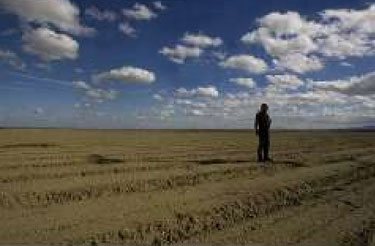 Image:
video grab of Firebaugh drought Image:
video grab of Firebaugh drought"Billy Bob Thornton tells Bruce Willis that a huge asteroid is approaching Earth,'' says Coburn, 40. "Willis asks Thornton who will get hurt, and Thornton tells him that he just doesn't get it — that everyone will be dead, that the game is over.'' The disaster coming this spring and summer is no movie, and nothing menacing is falling from the sky. It's about what's not falling from the sky — rain. After three years of below-average rain and snowfall, coupled with new pumping restrictions to protect endangered fish, California's farmers are running out of water. The devastating impact has trickled down to dozens of small Central Valley farming communities. This is the story about one of those towns: Firebaugh. It's also about Armando Ramirez, a 63-year-old barbershop owner on Firebaugh's main street who says business is down 90% from last year. It's about Manuel Rivera, 20, who is hoping against hope that he can keep the lights on at his clothing and jewelry store across the street. And it's about Randy, Frank, Steve and Larry Gonzales, four friendly brothers who say their family's half-century-old auto-parts and repair business around the corner is withering because farmworkers are driving less and getting laid off in droves. The farmers who will be slammed the hardest are those who depend on the Central Valley Project, the massive federal system of dams, reservoirs, pumps and canals that helped spawn California's $36 billion farming industry — the state's largest. MANY TOWNS WORRIED Within a couple of years, Coburn says, numerous small towns like Firebaugh could die and hundreds of thousands of once-profitable acres could turn into fields of dust. Beginning today, the federal water spigot in California has been turned off for the first time. And just as in "Armageddon,'' the game might be over. Across the Central Valley, warns a new University of California-Davis study, 80,000 jobs could be lost this year. In Firebaugh, a historic town of 7,000, one of the first casualties could be the Silver Creek Almond Co., which Coburn co-founded five years ago to pack and market the almonds he grows on 1,500 acres. All of the water used to nourish Coburn's orchards comes from the Central Valley Project. And on Feb. 20, federal water officials announced a "zero allocation'' to farmers — most likely for the rest of the year. Farmers who depend on water from the State Water Project are only slightly luckier — they have been told their allocation will be 15% of normal. "In a few years this will all be gone,'' Coburn predicted as he walked through a cavernous warehouse stacked with bins containing 10 million pounds of almonds, about 70% of which will be sent overseas. "Think of the business that will be lost at the Port of Oakland,'' Coburn said. "This is all going toward reducing our trade deficit.'' BUSINESS WAY DOWN Back on O Street, the main drag of downtown Firebaugh, is shrouded in sadness. Ramirez, the barber, says he understands why many of his longtime customers can no longer afford even a $10 haircut. Rivera, who owns the clothing and jewelry store Xavier & Sariah Styles with his mom, says his business is down the same as Ramirez's — 90% from a year ago. "We're now ringing up only $50 in sales a day,'' Rivera said. The rough times for Firebaugh started in August 2007 when U.S. District Court Judge Oliver Wanger reduced the amount of water pumped from the Sacramento-San Joaquin River Delta to protect the delta smelt, a tiny fish, from extinction. The new restrictions decreased farming on the west side of the Central Valley, which is much more dependent on federal water than the east side. The water nightmare caused by the pumping restrictions and dry weather has hit Main Street at a time when the recession and housing foreclosure crisis already are pummeling valley towns. In the past year, a third of Firebaugh's downtown businesses have closed. They include an ice cream shop, a Western clothing store and a once-popular Mexican restaurant. Even the lone bar catering to farm laborers was shuttered. Firebaugh, settled during the Gold Rush as a major ferry crossing for prospectors heading up the San Joaquin River, is now about 90% Latino. The city's official jobless rate is 23%. But Jose Ramirez, Firebaugh's city manager, estimates it's probably closer to 35% because so many undocumented workers don't make it into the official statistics. In the past year, sales tax revenue has plunged more than 40%. And the nightmare is just beginning. WELLS NO SOLUTION The huge Westlands Water District, wholly dependent on federal water, predicts up to 400,000 acres of its 611,000 acres of farmland will lie fallow this year. Farmers such as Coburn are spending millions of dollars desperately digging wells. But the water underground contains so much salt and boron it will kill orchards and vineyards in two or three years. "Putting our well water on almond trees is like giving them chemotherapy,'' Coburn said. "It will fry them.'' Back in town, Steve Malanca, general manager of the John Deere dealership, gazes at a former alfalfa field across the street. Malanca doesn't just see bare dirt. He conjures up the image of the tractor and the 30-foot-wide disk needed to prepare the field to grow alfalfa. He sees all the irrigation and seeding equipment — and crews — needed to get the alfalfa seeds in the ground; the companies needed to make the fertilizers and insecticides to ensure that the seeds germinate; the experts with advanced degrees needed to inspect the fields and help farmers design their battle plans against pests and disease. He sees four other pieces of equipment — a swather, hay rake, baler and harrow bed — that are needed before a semitrailer with a forklift loads the hay for delivery to a dairy. "Without water,'' Malanca said, "none of that will happen.'' The stress and depression that often accompany layoffs are taking their toll. Firebaugh Police Chief Elsa Lopez has noticed a recent uptick in domestic violence calls. And the number of people arrested on drunken-driving charges in January was double what it was a year ago. With sales tax revenue tanking, the city is asking its employees to take one furlough day a month to try to head off layoffs. But Lopez resisted calls for furloughs for her 12 sworn officers, fearing that layoffs on the farms will increase drug use, which in turn will lead to more burglaries and robberies. In lieu of the furloughs, Ramirez is asking that the cops not be paid for any holidays. MANY SUFFER DEPRESSION If things in Firebaugh weren't difficult enough, Premier Paso, the town's lone substance-abuse center, closed in September because state legislators were late passing a budget. "Losing them was a sad day for us,'' Lopez said. Dr. Marcia Sablan and her husband, Dr. Oscar Sablan, who for the past 27 years have run a Firebaugh medical clinic, say they are treating many more farm employees for depression. On Wednesday, Maria Linares, 38, brought her 17-year-old son to the clinic because he was sick. While she was there, she spoke to "Dr. Marcia,'' who also happens to be the town's mayor, about the anxiety at home. Linares' husband, an irrigation supervisor at an almond ranch in Firebaugh, is losing self-esteem, she said. He is now working only one or two days a week and fears he'll lose his job. And her job is also at risk: She works on the almond processing line at Coburn's Silver Creek Almond Co. If her husband does lose his job, Linares said, they will probably be forced to leave the trailer they paid $35,000 for three years ago so they could live on the almond ranch. Once upon a time they looked forward to moving from the trailer into a house in the heart of town. "But that dream,'' she said, "has all been erased because we have no water.'' http://www.contracostatimes.com/california/ci_11809845 |
|||||||||
Monday, February 9, 2009*****Catastrophic Fall in 2009 Global Food Production***** by Eric deCarbonnelAfter reading about the droughts in two major
agricultural countries, China and Argentina, I
decided to research the extent other food
producing nations were also experiencing
droughts. This project ended up taking a lot
longer than I thought. 2009 looks to be a
humanitarian disaster around much of the world
Now, consider the same graphic with the countries experiencing droughts highlighted
China The drought in Northern China, the worst in 50 years, is worsening, and summer harvest is now threatened. The area of affected crops has expanded to 161 million mu (was 141 million last week), and 4.37 million people and 2.1 million livestock are facing drinking water shortage. The scarcity of rain in some parts of the north and central provinces is the worst in recorded history. The drought which started in November threatens over half the wheat crop in eight provinces - Hebei, Shanxi, Anhui, Jiangsu, Henan, Shandong, Shaanxi and Gansu. Henan China's largest crop producing province, Henan, has issued the highest-level drought warning. Henan has received an average rainfall of 10.5 millimeters since November 2008, almost 80 percent less than in the same period in the previous years. The Henan drought, which began in November, is the most severe since 1951. Anhui Anhui Province issued a red drought alert, with more than 60 percent of the crops north of the Huaihe River plagued by a major drought. Shanxi Shanxi Province was put on orange drought alert on Jan. 21, with one million people and 160,000 heads of livestock are facing water shortage. Jiangsu Jiangsu province has already lost over one fifth of the wheat crops affected by drought. Local agricultural departments are diverting water from nearby rivers in an emergency effort to save the rest. Hebei Over 100 million cubic meters of water has been channeled in from outside the province to fight Hebei’s drought. Shaanxi 1.34 million acres of crops across the bone-dry Shanxi province are affected by the worsening drought. Shandong Since last November, Shandong province has experienced 73 percent less rain than the same period in previous years, with little rainfall forecast for the future. Relief efforts are under way. The Chinese government has allocated 86.7 billion yuan (about $12.69 billion) to drought-hit areas. Authorities have also resorted to cloud-seeding, and some areas received a sprinkling of rain after clouds were hit with 2,392 rockets and 409 cannon shells loaded with chemicals. However, there is a limit to what can be done in the face of such widespread water shortage. As I have previously written, China is facing hyperinflation, and this record drought will make things worse. China produces 18% of the world's grain each year. Australia Australia has been experiencing an unrelenting drought since 2004, and 41 percent of Australia's agriculture continues to suffer from the worst drought in 117 years of record-keeping. The drought has been so severe that rivers stopped flowing, lakes turned toxic, and farmers abandoned their land in frustration: A) The Murray River stopped flowing at its terminal point, and its mouth has closed up. B) Australia’s lower lakes are evaporating, and they are now a meter (3.2 feet) below sea level. If these lakes evaporate any further, the soil and the mud system below the water is going to be exposed to the air. The mud will then acidify, releasing sulfuric acid and a whole range of heavy metals. After this occurs, those lower lake systems will essentially become a toxic swamp which will never be able to be recovered. The Australian government's only options to prevent this are to allow salt water in, creating a dead sea, or to pray for rain. For some reason, the debate over climate change is essentially over in Australia. The United States California California is facing its worst drought in recorded history. The drought is predicted to be the most severe in modern times, worse than those in 1977 and 1991. Thousands of acres of row crops already have been fallowed, with more to follow. The snowpack in the Northern Sierra, home to some of the state's most important reservoirs, proved to be just 49 percent of average. Water agencies throughout the state are scrambling to adopt conservation mandates. Texas The Texan drought is reaching historic proportion. Dry conditions near Austin and San Antonio have been exceeded only once before—the drought of 1917-18. 88 percent of Texas is experiencing abnormally dry conditions, and 18 percent of the state is in either extreme or exceptional drought conditions. The drought areas have been expanding almost every month. Conditions in Texas are so bad cattle are keeling over in parched pastures and dying. Lack of rainfall has left pastures barren, and cattle producers have resorted to feeding animals hay. Irreversible damage has been done to winter wheat crops in Texas. Both short and long-term forecasts don't call for much rain at all, which means the Texas drought is set to get worse. Augusta Region (Georgia, South Carolina, North Carolina) The Augusta region has been suffering from a worsening two year drought. Augusta’s rainfall deficit is already approaching 2 inches so far in 2009, with January being the driest since 1989. Florida Florida has been hard hit by winter drought, damaging crops, and half of state is in some level of a drought. La Niña likely to make matters worse Enough water a couple of degrees cooler than normal has accumulated in the eastern part of the Pacific to create a La Niña, a weather pattern expected to linger until at least the spring. La Niña generally means dry weather for Southern states, which is exactly what the US doesn’t need right now.  South America Argentina The worst drought in half a century has turned Argentina's once-fertile soil to dust and pushed the country into a state of emergency. Cow carcasses litter the prairie fields, and sun-scorched soy plants wither under the South American summer sun. Argentina's food production is set to go down a minimum of 50 percent, maybe more. The country's wheat yield for 2009 will be 8.7 million metric tons, down from 16.3 million in 2008. Concern with domestic shortages (domestic wheat consumption being approximately 6.7 million metric ton), Argentina has granted no new export applications since mid January. Brazil Brazil has cut its outlook for the crops and will do so again after assessing damage to plants from desiccation in drought-stricken regions. Brazil is the world's second-biggest exporter of soybeans and third-largest for corn. Brazil's numbers for corn harvesting: Harvested in 2008: 58.7 million tons January 8 forecast: 52.3 million tons February 6 forecast: 50.3 metric tons (optimistic) Harvested in 2009: ??? Paraguay Severe drought affecting Paraguay's economy has pushed the government to declare agricultural emergency. Crops that have direct impact on cattle food are ruined, and the soy plantations have been almost totally lost in some areas. Uruguay Uruguay declared an "agriculture emergency" last month, due to the worst drought in decades which is threatening crops, livestock and the provision of fresh produce. The a worsening drought is pushing up food and beverage costs causing Uruguay's consumer prices to rise at the fastest annual pace in more than four years in January. Bolivia There hasn’t been a drop of rain in Bolivia in nearly a year. Cattle dying, crops ruined, etc… Chile The severe drought affecting Chile has caused an agricultural emergency in 50 rural districts, and large sectors of the economy are concerned about possible electricity rationing in March. The countries woes stem from the "La Niña" climate phenomenon which has over half of Chile dangling by a thread: persistently cold water in the Pacific ocean along with high atmospheric pressure are preventing rain-bearing fronts from entering central and southern areas of the country. As a result, the water levels at hydroelectric dams and other reservoirs are at all-time lows. Horn of Africa Africa faces food shortages and famine. Food production across the Horn of Africa has suffered because of the lack of rainfall. Also, half the agricultural soil has lost nutrients necessary to grow plant, and the declining soil fertility across Africa is exacerbating drought related crop losses. Kenya Kenya is the worst hit nation in the region, having been without rainfall for 18 months. Kenya needs to import food to bridge a shortfall and keep 10 million of its people from starvation. Kenya’s drought suffering neighbors will be of little help. Tanzania A poor harvest due to drought has prompted Tanzania to stop issuing food export permits. Tanzania has also intensified security at the border posts to monitor and prevent the export of food. There are 240,000 people in need of immediate relief food in Tanzania. Burundi Crops in the north of Burundi have withered, leaving the tiny East African country facing a severe food shortage Uganda Severe drought in northeastern Uganda's Karamoja region has the left the country on the brink of a humanitarian catastrophe. The dry conditions and acute food shortages, which have left Karamoja near starvation, are unlikely to improve before October when the next harvest is due. South Africa South Africa faces a potential crop shortage after wheat farmers in the eastern part of the Free State grain belt said they were likely to produce their lowest crop in 30 years this year. South Africans are "extremely angry" that food prices continue to rise. Other African nations suffering from drought in 2009 are: Malawi, Zambia, Swaziland, Somalia, Zimbabwe, Mozambique, Tunisia, Angola, and Ethiopia. Middle East and Central Asia The Middle East and Central Asia are suffering from the worst droughts in recent history, and food grain production has dropped to some of the lowest levels in decades. Total wheat production in the wider drought-affected region is currently estimated to have declined by at least 22 percent in 2009. Owing to the drought's severity and region-wide scope, irrigation supplies from reservoirs, rivers, and groundwater have been critically reduced. Major reservoirs in Turkey, Iran, Iraq, and Syria are all at low levels requiring restrictions on usage. Given the severity of crop losses in the region, a major shortage of planting seed for the 2010 crop is expected. Iraq In Iraq during the winter grain growing period, there was essentially no measurable rainfall in many regions, and large swaths of rain-fed fields across northern Iraq simply went unplanted. These primarily rain-fed regions in northern Iraq are described as an agricultural disaster area this year, with wheat production falling 80-98 percent from normal levels. The USDA estimates total wheat production in Iraq in 2009 at 1.3 million tons, down 45 percent from last year. Syria Syria is experienced its worst drought in the past 18 years, and the USDA estimates total wheat production in Syria in 2009 at 2.0 million tons, down 50 percent from last year. Last summer, the taps ran dry in many neighborhoods of Damascus and residents of the capital city were forced to buy water on the black market. The severe lack of rain this winter has exacerbated the problem. Afghanistan Lack of rainfall has led Afghanistan to the worst drought conditions in the past 10 years. The USDA estimates 2008/09 wheat production in Afghanistan at 1.5 million tons, down 2.3 million or 60 percent from last year. Afghanistan normally produces 3.5-4.0 million tons of wheat annually. Jordan Jordan's persistent drought has grown worse, with almost no rain falling on the kingdom this year. The Jordanian government has stopped pumping water to farms to preserve the water for drinking purposes. Other Middle Eastern and Central Asian nations suffering from drought in 2009 are: The Palestinian Territories, Lebanon, Israel, Bangladesh, Myanmar, India, Tajikistan, Turkmenistan, Thailand, Nepal, Pakistan, Turkey, Kyrgyzstan, Uzbekistan, Cyprus, and Iran. Lack of credit will worsen food shortage A lack of credit for farmers curbed their ability to buy seeds and fertilizers in 2008/2009 and will limit production around the world. The effects of droughts worldwide will also be amplified by the smaller amount of seeds and fertilizers used to grow crops. Low commodity prices will worsen food shortage The low prices at the end of 2008 discouraged the planting of new crops in 2009. In Kansas for example, farmers seeded nine million acres, the smallest planting for half a century. Wheat plantings this year are down about 4 million acres across the US and about 1.1 million acres in Canada. So even discounting drought related losses, the US, Canada, and other food producing nations are facing lower agricultural output in 2009. Europe will not make up for the food shortfall Europe, the only big agricultural region relatively unaffected by drought, is set for a big drop in food production. Due to the combination of a late plantings, poorer soil conditions, reduced inputs, and light rainfall, Europe’s agricultural output is likely to fall by 10 to 15 percent. Stocks of foodstuff are dangerously low Low stocks of foodstuff make the world’s falling agriculture output particularly worrisome. The combined averaged of the ending stock levels of the major trading countries of Australia, Canada, United States, and the European Union have been declining steadily in the last few years: 2002-2005: 47.4 million tons 2007: 37.6 million tons 2008: 27.4 million tons These inventory numbers are dangerously low, especially considering the horrifying possibility that China’s 60 million tons of grain reserves doesn't actually exists. Global food Catastrophe The world is heading for a drop in agricultural production of 20 to 40 percent, depending on the severity and length of the current global droughts. Food producing nations are imposing food export restrictions. Food prices will soar, and, in poor countries with food deficits, millions will starve. The deflation debate should end now The droughts plaguing the world’s biggest agricultural regions should end the debate about deflation in 2009. The demand for agricultural commodities is relatively immune to developments in the business cycles (at least compared to that of energy or base metals), and, with a 20 to 40 percent decline in world production, already rising food prices are headed significantly higher. In fact, agricultural commodities NEED to head higher and soon, to prevent even greater food shortages and famine. The price of wheat, corn, soybeans, etc must rise to a level which encourages the planting of every available acre with the best possible fertilizers. Otherwise, if food prices stay at their current levels, production will continue to fall, sentencing millions more to starvation. Competitive currency appreciation Some observers are anticipating “competitive currency devaluations” in addition to deflation for 2009 (nations devalue their currencies to help their export sector). The coming global food shortage makes this highly unlikely. Depreciating their currency in the current environment will produce the unwanted consequence of boosting exports—of food. Even with export restrictions like those in China, currency depreciation would cause the outflow of significant quantities of grain via the black market. Instead of “competitive currency devaluations”, spiking food prices will likely cause competitive currency appreciation in 2009. Foreign exchange reserves exist for just this type of emergency. Central banks around the world will lower domestic food prices by either directly selling off their reserves to appreciate their currencies or by using them to purchase grain on the world market. Appreciating a currency is the fastest way to control food inflation. A more valuable currency allows a nation to monopolize more global resources (ie: the overvalued dollar allows the US to consume 25% of the world's oil despite having only 4% of the world's population). If China were to selloff its US reserves, its enormous population would start sucking up the world's food supply like the US has been doing with oil. On the flip side, when a nation appreciates its currency and starts consuming more of the world’s resources, it leaves less for everyone else. So when china appreciates the yuan, food shortages worldwide will increase and prices everywhere else will jump upwards. As there is nothing that breeds social unrest like soaring food prices, nations around the world, from Russia, to the EU, to Saudi Arabia, to India, will sell off their foreign reserves to appreciate their currencies and reduce the cost of food imports. In response to this, China will sell even more of its reserves and so on. That is competitive currency appreciation. When faced with competitive currency appreciation, you do NOT want to be the world’s reserve currency. The dollar is likely to do very poorly as central banks liquidate trillions in US holdings to buy food and appreciate their currencies. http://www.marketskeptics.com/2009/02/2009-global-food-catastrophe.html
|
|||||||||
|
California likely to experience its worst droughtby Camilla Abad - January 30, 2009California, January 30: California is possibly entering its third and worst year of drought, state officials announced on Thursday. A snow survey conducted by the California Department of Water Resources Aside from this, the usual 20 percent of California’s annual precipitation achieved during the month of January did not occur. Instead, the state experienced many dry days during the first month of this year. The dry weather the state experiences is because of the pressure exerted by the increasing population on the state’s water system, together with aging infrastructure and reductions in water being pumped through the Sacramento-San Joaquin River Delta as ordered by the court. Elisa Lynn, chief meteorologist with the Department of Water Resources, said, “We're definitely in really bad shape. People can expect to pay higher prices for produce ... and more agencies may be rationing ... some raising fees. We just don't have enough water." Water managers from the Sonoma County are already expected to inform residents of severe water rationing on Monday. Pam Jeane, the deputy chief engineer of operations at the Sonoma County Water Agency, said, “We have entered uncharted territory. A 30 percent mandatory rationing order is just the beginning. Further decline in reservoir levels could necessitate 50 percent cutbacks." Other districts are counting on residents to do voluntary cutbacks. San Francisco has already asked the residents to decrease their water consumption by 10 percent but as the spring enters the city together with others in the state, it may impose rationing. After two consecutive years of drought in the state and a third one well on its way, the water contained in Lake Mendocino is now down to only 32,000 acre-feet. The lake, which supplies 750,000 residents in the Marin and Sonoma counties, has a capacity of 90,000 acre-feet. In Lake Shasta, the biggest reservoir in the state, the amount of water is also down to 31 percent of its capacity. California Governor Arnold Schwarzenegger reported his plan to create a $9 billion water bond in order to help the state overcome the drought. This bond will be used to create new dams and reservoirs as well as for water recycling and conservation programs.
|
|||||||||
|
Melbourne
faces worst hot spell in 100 years (January 27, 2009) http://www.theage.com.au/national/melbourne-faces-worst-hot-spell-in-100-years-20090126-7q0c.html MELBURNIANS, brace yourselves. Over the the next five days, we are in for the longest heatwave experienced here in recorded times. Today will be the start of five days of unrelenting scorchers with temperatures soaring to the 40s. The last time Melbourne had a heatwave of this intensity was a century ago when it suffered through five days of stultifying heat with temperatures in the 40s in January 1908. The stifling heat will extend across the state, with the only respite in coastal areas such as Airey's Inlet, where sea breezes can be expected. (...) This week's heatwave comes in the driest January since 1932 when just 0.3 of a millimetre rain fell.Rainfall this month has been 0.8 of a millimetre. With the bureau predicting no further rain this month, it is set to be the second driest January in 159 years of record keeping.The big dry has left Melbourne's water storages levels at 33.6 per cent capacity. Australia suffers worst heatwave for a century (28 Jan 2009) http://www.telegraph.co.uk/news/worldnews/australiaandthepacific/australia/4373473/Australia-suffers-worst-heatwave-for-a-century.html Australia is battling the highest temperatures in almost a century as a ‘brutal' heatwave grips the country. -- The mercury reached 114F (45.6C) in Adelaide on Wednesday, the hottest temperature the city has experienced in 70 years and just shy of its all-time record of 115F. In Melbourne, furnace-like conditions caused disruption at the Australian Open, making a civilised game of tennis almost impossible. Organisers were forced to interrupt the tournament when temperatures on court rose to 46.7C. The city, which is used to days of around 77F at this time of year, later recorded a top temperature of 110F. But weather experts have warned residents of the states of Victoria and South Australia to expect worse to come. CLIP Victoria prepares for worst heatwave in a century (January 27, 2009) http://www.theaustralian.news.com.au/story/0,25197,24968430-5006785,00.html A TOTAL fire ban has been declared in most parts of Victoria for tomorrow with temperatures set to soar above 40C. The ban takes affect from midnight tonight in the north western, north eastern, south western and central districts. Victoria is facing its worst heatwave in a century, with firefighters, rail operators and power companies on red alert.Department of Sustainability and Environment chief fire officer Ewan Waller said all of Victoria's forests were carrying high fuel loads as a result of 12 years of drought. "Forest fuels are at extreme levels and are all available to burn and burn with extreme intensity and that is a real concern," he said. The extreme heat started today with a forecast top of 38C for Melbourne followed by four days of 40C-plus. Mildura hit 37.5C by about noon. The mercury is expected to crash through 40C every day this week in regional centres including Mildura, Shepparton and Bendigo, the Herald Sun reports.Premier John Brumby will hold a crisis meeting with emergency services today to discuss contingency plans to cope with the extreme heat. "We haven't seen conditions like this certainly for 100 years, possibly in our modern history since records began. It is going to be quite a challenge," he said. CLIP MANY more related news through this LINK |
|||||||||
|
Feb. 2, 2009 ECHO SUMMIT, Calif. (AP) — State officials reported a Sierra Nevada snowpack smaller than normal on Thursday and said California may be at the beginning of its worst drought in modern history. Residents were immediately urged to conserve water.The snowpack was about 61% of its usual depth across the 400-mile-long mountain range, according to the state Department of Water Resources, which released the findings as part of the second snow survey of the season. Department Director Lester Snow said the results indicate California could be heading for a third dry year. "We may be at the start of the worst California drought in modern history," Snow said in a statement. "It's imperative for Californians to conserve water immediately at home and in their businesses." Measurements of snow depth and snow water content in the Sierra are important because they help hydrologists forecast how much water California can expect to get in the coming year. Levels were 49% of normal in the northern Sierra and about 63% of normal in the central region and 68% of normal in the southern region. California's largest reservoirs — Shasta and Oroville — are less than half as full as they should be for this time of year. The snowpack water content needs to be roughly double what it is today by April to replenish the reservoirs, said Don Strickland, a spokesman for the water agency. It's doubtful Mother Nature will grow the snowpack by that much. Felix Garcia, a meteorologist at the National Weather Service, said a La Nina weather pattern over the Pacific Ocean is pushing most of this year's winter storms past California. "The rain is happening but it's happening way north in Washington and in Canada," Garcia said. "It is expected to remain about the same for the next two to three months." The state has said it will deliver just 15% of its water contracts this year because of the low reservoir levels and court-ordered restrictions not to pump water to protect a threatened fish that lives in the Sacramento-San Joaquin Delta. The U.S. Bureau of Reclamation last week warned farmers that water deliveries would be low this year. The agency intends to release its annual delivery estimates next month. And in neighboring Nevada, the U.S. Agriculture Department has declared almost all of the state a natural disaster area because of losses caused by drought over the past year.
Copyright 2009 The Associated Press. All rights reserved.
|
|||||||||
|
|||||||||
| WATER DATABASE ON THIS SITE | |||||||||
